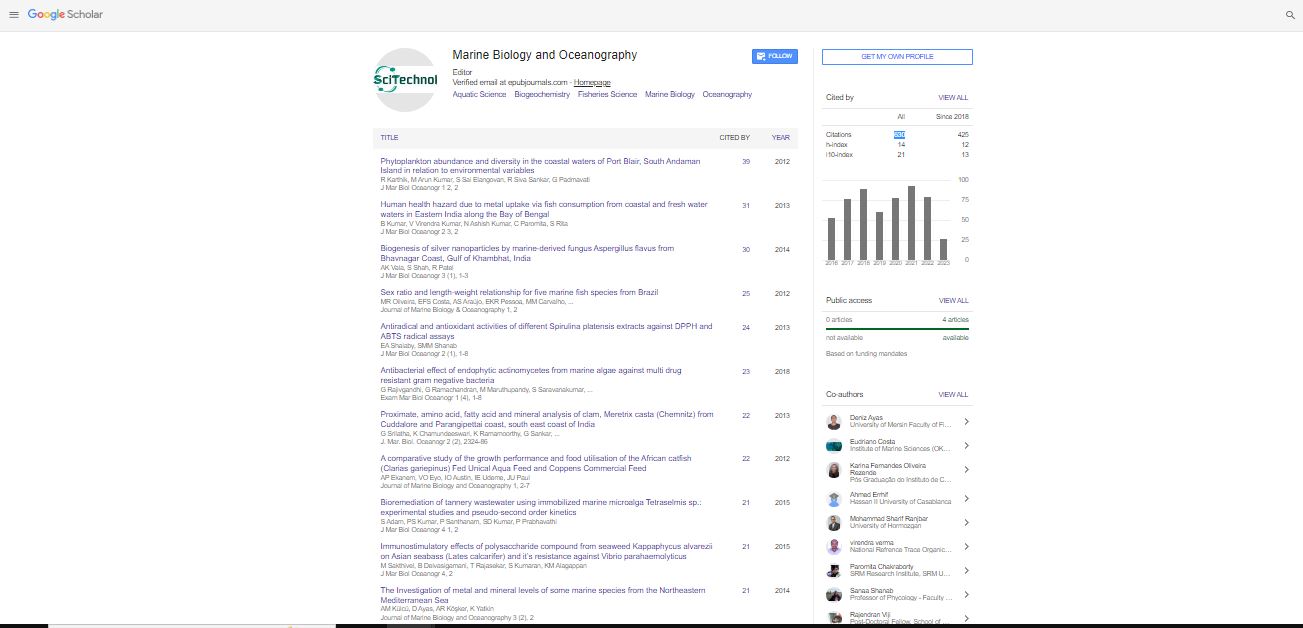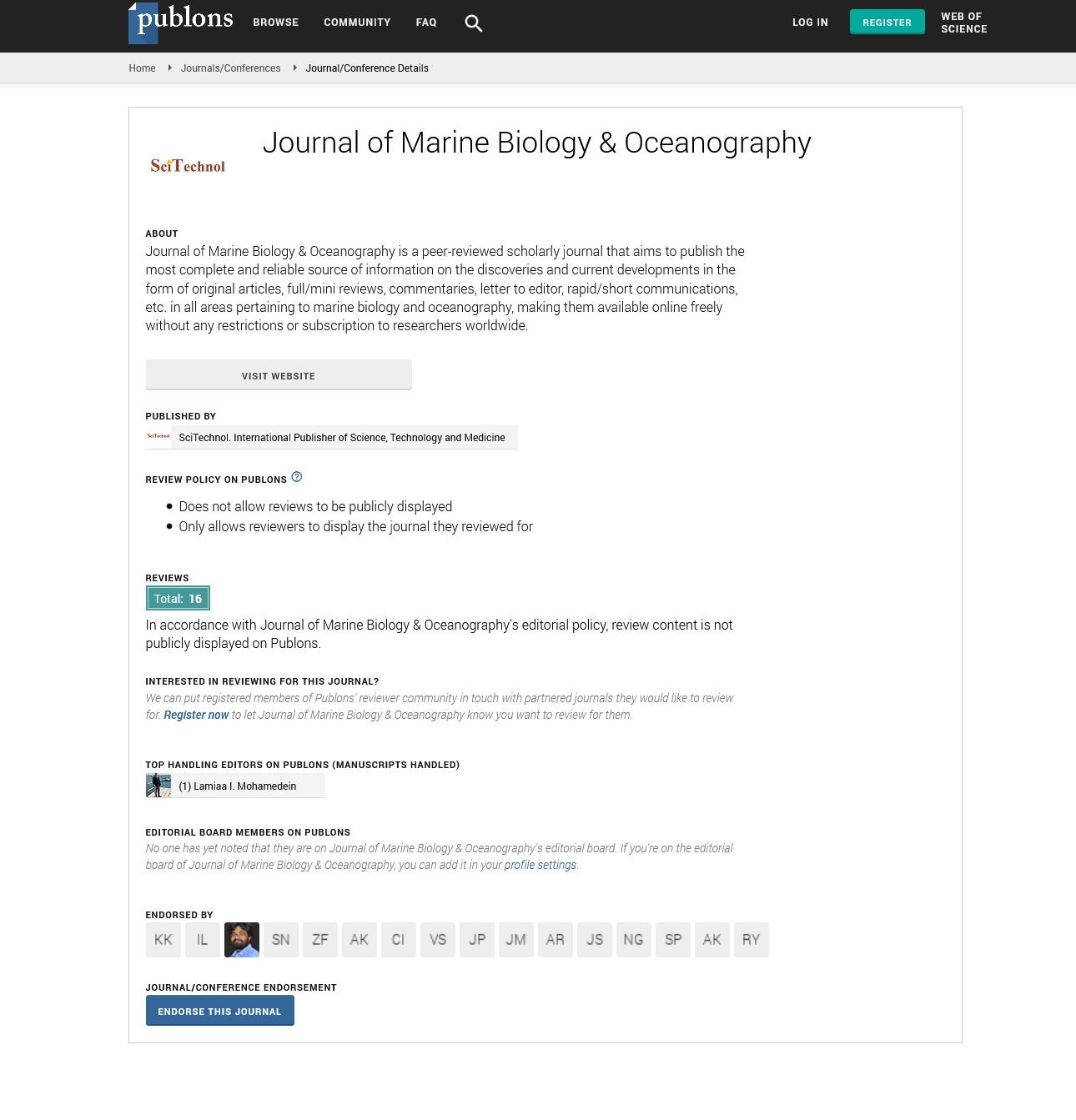Commentary, J Mar Biol Oceanogr Vol: 11 Issue: 2
Species Boundaries within Social Aggregations of Ecologically Similar Goby
Ajay Manglik *
Department of Pediatrics, National Geophysical Research Institute (CSIR-NGRI),Hyderabad,India
*Corresponding author: Ajay Manglik, Department of Pediatrics, National Geophysical Research Institute (CSIR-NGRI),Hyderabad,India, Email: rolandjun@gmail.com
Received date: 11 January, 2022, Manuscript No. JMBO-22-57165;
Editor assigned date: 13 January, 2022, Pre QC No. JMBO-22-57165 (PQ);
Reviewed date: 24 January, 2022, QC No JMBO-22-57165;
Revised date: 04 February, 2022, Manuscript No. JMBO-22-57165 (R);
Published date: 21 February, 2022, DOI:10.4172/jmbo.1000226
Keywords: Ecologically Similar Goby
Description
The conservation of species boundaries when openings for amalgamation are abundant is an inadequately understood miracle for numerous taxa. While numerous mechanisms for maintaining species boundaries have been described their relative significance depends largely on the particulars of the system in question. Aggregating social gets can be a means to keep sympatric family species distinct if it leads to isolation during reduplication. The wide Caribbean reef gobies Coryphopterus personates and C. hyalines are sympatric family species with nearly identical morphology that spend their entire adult lives in shallows in which reduplication occurs. To date no studies have delved whether shallows are species-specific, which would be anticipated if aggregating gets helps to maintain species boundaries. To address this, the species of individual fishes collected from shallows were linked using morphology, mitochondrial sequence data, and microsatellite allele frequentness. Situations of amalgamation between the species were also assessed. Shallows were generally composed of both species in analogous proportions to their relative abundances on the reef, where the shallows were plant, indicating that the species aren't behaviorally separating. For utmost samples, morphological, mitochondrial, and nuclear data were harmonious with a single species, but individualities showed dissensions with microsatellite genotypes of suggesting some position of major/contemporary amalgamation. Of these, two were linked as likely first-or alternate-generation mongrels or backcrosses. Despite co-occurrence and substantiation of some gene inflow, the two species show little amalgamation overall suggesting that micro scale differences in breeding point selection, allotropy, and or cryptic mate choice may play an important part in the conservation of species boundaries despite co-occurrence well within the range generally allowed of as sympathy. Little is known on the food and feeding ecology of the soft-plumaged petrel Pterodroma mollies, which is the single nuisance petrel Pterodroma spp with a circumpolar parentage distribution within the Southern Ocean. Our primary thing was to describe its diet at Kerguelen Islets, which is the southernmost parentage position of the species. Soft-plumaged petrels fed on fish, and digressively on crustaceans, while cephalopods and other particulars (<1) were minor salutary factors.
Encyclopedically Risked Group of Seabirds
Eight-hundred and sixty preys were linked from the pooled food samples, with the hyperacid amphipods being the main food particulars by number. Owing to their larger size than crustaceans, mesopelagic fishes were the main prey by mass, with myctophids being the most important fish family in terms of both cornucopia (68 of the fish) and diversity (10 species). Prey distribution indicated that soft-plumaged petrels grazed primarily in oceanic sub Antarctic waters to feed their sprats. The oceanic life style of nuisance petrels was also stressed by a review of their diet worldwide (20 species, 26 studies). Gadfly petrels prey substantially upon mesopelagic fishes (primarily myctophids) and squids with their relative proportions depending on species and points. Crustaceans are minor food particulars for tropical species, but they form a significant part of the food of the small-and medium-sized petrels that live in temperate and cold waters. The review underlines the need for more well-designed examinations on this encyclopedically risked group of seabirds, since salutary information is available for only 57 of the 35 species of nuisance petrels. The ranges of species are shifting as a consequence of anthropogenic climate change. In the marine realm biogeographic transition zones could form walls to disbandment and inhibit range-shift, but little is known about this implicit effect. The hermit grouser Clibanarius erythropus appeared in the UK in 2016 with the nearest reproducing population being on the northern seacoast of Brittany. This raises questions of which conditions may have permitted C. erythropus to cross the English Channel (7.25 ° W, 49.00°N) and whether this hedge could be overcome by other intertidal species. Disbandment simulations suggest the naiad’s of C. erythropus arrived in 2014, began from North Brittany, endured a mean temperature of around 16 °C, and took longer than 20 days to be transported across the channel. The transportation of naiads from Brittany to the southwest UK appears to be rare and driven by occasional, unusual ocean currents. The English Channel may continue to help species with pelagic naiads that settle within 20 days, similar as numerous species of gastropod, annelids, and macro algae, from successfully range expanding to the UK. North Brittany was the only mainland from which it's doable the UK population of C. erythropus could have begun. Thus, species with long-lived pelagic naiads but without reproducing populations in North Brittany may not appear in the southwest UK until the species are established in North Brittany. The English Channel could continue to limit the capability of numerous intertidal species to shift their range with climate change. Multistage processes through dynamic boundaries drive the original benefactions (oneness in species composition and cornucopia) and species benefactions (individual species cornucopia variation) to grope beta diversity in littoral seascapes. We partitioned (cornucopia difference), and used model- grounded approaches to probe whether seascape size influences environmental and spatial motorists of, and goods of species (distribution, frequency, and littoral dependence).
Multistage Mechanisms Dependent Data
Three large kudos (bay position) and three zones per bay (zone position), southeastern Brazil, were seascape models during 1 time. At the bay position, further locales had advanced, related to species composition, lower water translucency, and much lower to deluge/high runs and advanced number of arms was also current and stronger positive goods of translucency and mangrove cover corroborated the significance of environmental filtering and indispensable territories driving original benefactions to relief processes in larger seascapes. Species up cariousness told appreciatively primarily at the zone position, and negative goods of vegetal cover and primarily mortal agreements suggested species loss under lower diversity. Also, more analogous and substantiated the adding original benefactions to cornucopia differences in lower species pools. At both situations, larger-and finer-scale spatial goods substantiated possible influences of disbandment and biotic relations, independently was appreciatively related to species frequency at locales and distribution at both situations. Thus, multistate mechanisms dependent and irrespective of seascape size support the critical significance of niche vacuity, complexity, and variety to beta diversity of littoral fishes. Sweats for the conservation of green turtles (Chelonia mydas) in the Chagar Hutang Turtle Sanctuary (CHTS), Redang Island, Malaysia, have been in place for over two decades. Then we propose that the reclamation of new maters to this rookery has a significant influence on the recovery of nest cornucopia in the long term. A 2 –3 times’ quasi-periodic oscillation in nest cornucopia was also observed. This change might have been a consequence of El Niño-Southern Oscillation (ENSO), which affects ocean-face temperature in the South China Sea (SCS) in the months following El Niño/La Niña events. To test these suppositions, the number of clutches laid in the CHTS over a 24-time period was assessed via the Seasonal and Trend Decomposition by Loess (STL) algorithm. The long-term trend of nest cornucopia was shown to be dependent on the reclamation of new maters, while a 2–3 times’quasi-periodic oscillation in nest cornucopia showed a2.5-time-lagged negative correlation to the Oceanic Niño Index (ONI) and a 2-time-lagged negative correlation to the SST data series from SCS shallow waters, including known rustling grounds of green turtles nesting in the CHTS. In summary, we demonstrated that La-Niña peaks by dwindling SST in the SCS for the posterior semester promotes green turtle nesting after 2–3 times. These results punctuate the influence of broad climatological oscillations in the ocean turtles’ life cycle and the significance of conservation measures to secure their entire home range and life stages002E We used a 298-day (July to April) laboratory microcosm trial with Newfoundland green ocean imps (Strongly centrotus droebachiensis) to test the ratiocination that growth and feeding are largely innocent by light volume and quality within the visible- light diapason. Sea urchins educated either of three light surroundings bluffing differences in luminance and red/blue light rates among common territories for the species drift pool, shallow sub tidal, and deeper sub tidal territories. Sea imps were fed simply kelp (Alaria esculenta) and exposed to natural photoperiod. Light had no effect on body periphery and weight. Periphery, but not weight, changed over time with a low, yet statistically significant, 3 increase from August to February. Light also didn't affect feeding on kelp, which, still, differed significantly among the three slice months, peaking in November. Seasonal patterns of feeding in the microcosms followed that in natural territories. Our findings speak largely to the relative insensitivity of the species to its visible-light terrain within the range tested. They also support the paradigm that in green ocean devil, visible-light volume and quality have an important lower impact on physical and gonadic growth and feeding than food quality and vacuity.
 Spanish
Spanish  Chinese
Chinese  Russian
Russian  German
German  French
French  Japanese
Japanese  Portuguese
Portuguese  Hindi
Hindi 
